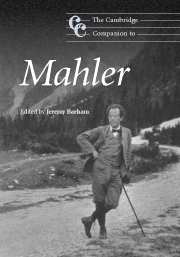Book contents
- Frontmatter
- Introduction: Marginalia on Mahler today
- PART ONE Cultural contexts
- 1 Socio-political landscapes: reception and biography
- 2 The literary and philosophical worlds of Gustav Mahler
- 3 Music and aesthetics: the programmatic issue
- PART TWO Mahler the creative musician
- PART THREE Mahler the re-creative musician
- PART FOUR Reception and performance
- Appendix: selected discography
- Notes
- Bibliography
- Index
3 - Music and aesthetics: the programmatic issue
from PART ONE - Cultural contexts
Published online by Cambridge University Press: 28 September 2011
- Frontmatter
- Introduction: Marginalia on Mahler today
- PART ONE Cultural contexts
- 1 Socio-political landscapes: reception and biography
- 2 The literary and philosophical worlds of Gustav Mahler
- 3 Music and aesthetics: the programmatic issue
- PART TWO Mahler the creative musician
- PART THREE Mahler the re-creative musician
- PART FOUR Reception and performance
- Appendix: selected discography
- Notes
- Bibliography
- Index
Summary
Evaluating a composer's aesthetics of music and its relation to programmes is fraught with difficulties, not least because the historical meaning of aesthetics as a discipline has undergone changes since its early, 1750 definition by Alexander Baumgarten: ‘Aesthetics (a theory of liberal arts, of inferior mode of knowledge, the art of beautiful thinking, in a way analogous to thinking about reason [logic]), is the science of sensual cognition’. It was thus conceived as a philosophical category denoting the knowledge of the beautiful through the senses (a lower form of knowledge than logic, which deals with intellectual concepts). By the middle of the nineteenth century, as universalist philosophical aesthetic theories distanced themselves from professional criticism, the demise of the metaphysics of the beautiful became inevitable. Music criticism which centred more directly on the musical works themselves, and addressed more practical questions of knowledge and meaning was able to come closer to elucidating the inner workings of music, and thus became more influential in the aesthetic tastes of the time. This situation was recognized by none other than Eduard Hanslick, the aesthetician of ‘absolute music’ when he wrote in 1854: ‘Formerly, the aesthetic principles of the various arts were supposed to be governed by some supreme metaphysical principle of general aesthetics. Now, however, the conviction is daily growing that each individual art can be understood only by studying its technical limits and inherent nature.’
- Type
- Chapter
- Information
- The Cambridge Companion to Mahler , pp. 35 - 48Publisher: Cambridge University PressPrint publication year: 2007



